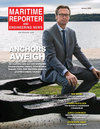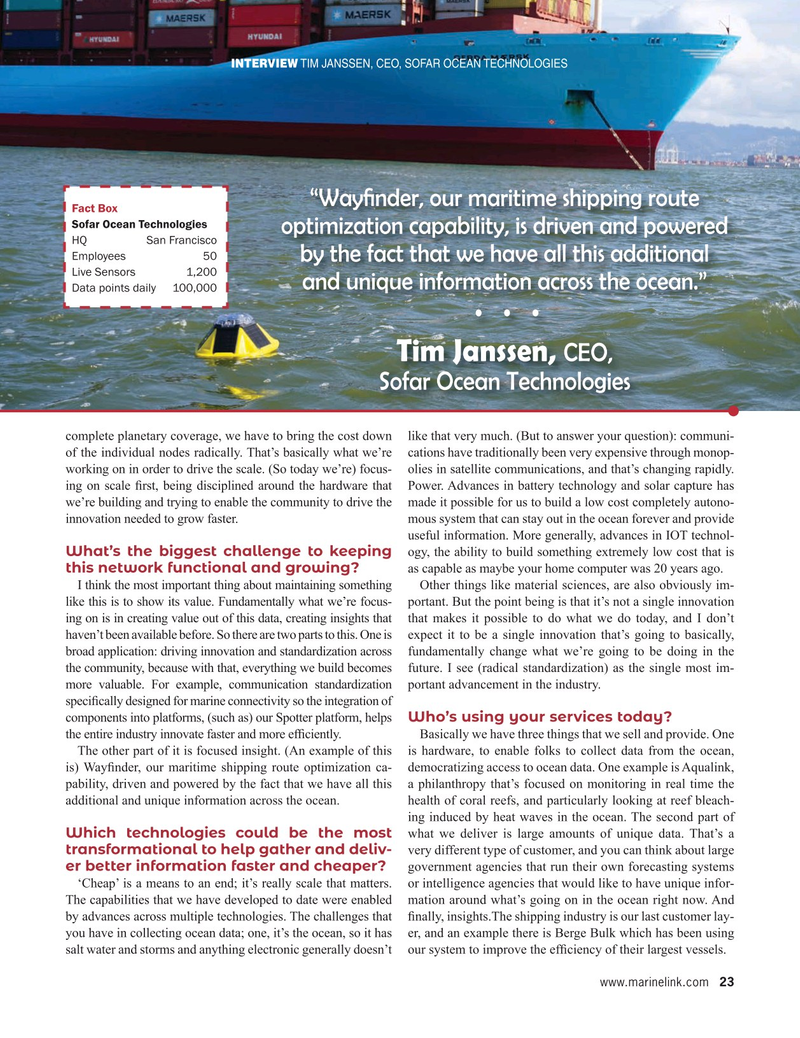
Page 23: of Maritime Reporter Magazine (January 2022)
The Ship Repair & Conversion Edition
Read this page in Pdf, Flash or Html5 edition of January 2022 Maritime Reporter Magazine
INTERVIEW TIM JANSSEN, CEO, SOFAR OCEAN TECHNOLOGIES “Way? nder, our maritime shipping route
Fact Box
Sofar Ocean Technologies optimization capability, is driven and powered
HQ San Francisco
Employees 50 by the fact that we have all this additional
Live Sensors 1,200 and unique information across the ocean.”
Data points daily 100,000 . . .
Tim Janssen, CEO,
Sofar Ocean Technologies complete planetary coverage, we have to bring the cost down like that very much. (But to answer your question): communi- of the individual nodes radically. That’s basically what we’re cations have traditionally been very expensive through monop- working on in order to drive the scale. (So today we’re) focus- olies in satellite communications, and that’s changing rapidly. ing on scale ? rst, being disciplined around the hardware that Power. Advances in battery technology and solar capture has we’re building and trying to enable the community to drive the made it possible for us to build a low cost completely autono- innovation needed to grow faster. mous system that can stay out in the ocean forever and provide useful information. More generally, advances in IOT technol- ogy, the ability to build something extremely low cost that is
What’s the biggest challenge to keeping this network functional and growing?
as capable as maybe your home computer was 20 years ago.
I think the most important thing about maintaining something Other things like material sciences, are also obviously im- like this is to show its value. Fundamentally what we’re focus- portant. But the point being is that it’s not a single innovation ing on is in creating value out of this data, creating insights that that makes it possible to do what we do today, and I don’t haven’t been available before. So there are two parts to this. One is expect it to be a single innovation that’s going to basically, broad application: driving innovation and standardization across fundamentally change what we’re going to be doing in the the community, because with that, everything we build becomes future. I see (radical standardization) as the single most im- more valuable. For example, communication standardization portant advancement in the industry.
speci? cally designed for marine connectivity so the integration of components into platforms, (such as) our Spotter platform, helps Who’s using your services today?
the entire industry innovate faster and more ef? ciently. Basically we have three things that we sell and provide. One
The other part of it is focused insight. (An example of this is hardware, to enable folks to collect data from the ocean, is) Way? nder, our maritime shipping route optimization ca- democratizing access to ocean data. One example is Aqualink, pability, driven and powered by the fact that we have all this a philanthropy that’s focused on monitoring in real time the additional and unique information across the ocean. health of coral reefs, and particularly looking at reef bleach- ing induced by heat waves in the ocean. The second part of
Which technologies could be the most what we deliver is large amounts of unique data. That’s a transformational to help gather and deliv- very different type of customer, and you can think about large er better information faster and cheaper?
government agencies that run their own forecasting systems ‘Cheap’ is a means to an end; it’s really scale that matters. or intelligence agencies that would like to have unique infor-
The capabilities that we have developed to date were enabled mation around what’s going on in the ocean right now. And by advances across multiple technologies. The challenges that ? nally, insights.The shipping industry is our last customer lay- you have in collecting ocean data; one, it’s the ocean, so it has er, and an example there is Berge Bulk which has been using salt water and storms and anything electronic generally doesn’t our system to improve the ef? ciency of their largest vessels.
www.marinelink.com 23
MR #1 (18-33).indd 23 1/6/2022 2:49:55 PM

 22
22

 24
24
